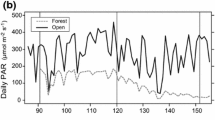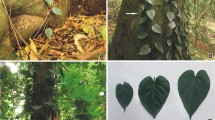Abstract
Near-ground temperatures strongly influence Arctic plant growth, reproduction, maturation and phenological relations with pollinators and herbivores. Those temperatures become further elevated within plant parts through passive solar heating, e.g. dish-shaped blossoms that focus insolation and heat-trapping pubescent structures. Other Arctic plants gain heat in hollow structures that possibly function as microgreenhouses. Arctic plants with hollow flowers in which intrafloral temperatures and temperature excesses (i.e. above nearby air) were recorded are Silene sorensenis and S. uralensis (Caryophyllaceae) with globose syncalyces, and Pedicularis langsdorfii and P. capitata (Orobanchaceae) with sympetalous corollas. The flowers heated passively, as microgreenhouses, in sunshine but not under cloudy conditions. Lateral orientation to insolation maximizes intrafloral heating in Pedicularis spp. Temperature excesses up to about 6 °C probably accelerate development of the plants’ reproductive organs (gynoecium, androecium, fruits, seeds) through 25% additional heat units (growing degree days above 0°C) over the High Arctics short, cool, active season. How these phenomena exacerbate the effects of climate change remains to be assessed.


Similar content being viewed by others
References
Aiken SG, Dallwitz MJ, Consaul LL, McJannet CL, Boles RL, Argus GW, Gillett JM, Scott PJ, Elven R, LeBlanc MC, Gillespie LJ, Brysting AK, Solstad H, Harris JG (2007). Flora of the Canadian Arctic Archipelago: Descriptions, Illustrations, Identification, and Information Retrieval. NRC Research Press, National Research Council of Canada, Ottawa. http://nature.ca/aaflora/data. (accessed 5 October, 2020).
Brunet J, Ziobro R, Osvatic J, Clayton MK (2019) The effects of time, temperature and plant variety on pollen viability and its implications for gene flow risk. Plant Biol 21:715–722. https://doi.org/10.1111/plb.12959
Corbet PS (1973) The microclimate of arctic plants and animals, on land and in fresh water. Acta Arctica 18:1–43
Dafni A, Kevan PG (1997) Flower size and shape: Implications in pollination. Israel J Plant Sci 45:201–211
Gauslaa Y (1984) Heat-resistance and energy budget in different Scandinavian plants. Holarct Ecol 7(1):1–78
Gavrilova MK (1966) Radiation climate of the Arctic. Translation from Russian by Israel Program for Scientific, Washington, p 178
Henderson ST (1977) Daylight and its spectrum, 2nd edn. Adam Hilger, Bristol, UK
Høye TT, Post E, Schmidt NM, Trøjelsgaard K, Forchhammer MC (2013) Shorter flowering seasons and declining abundance of flower visitors in a warmer Arctic. Nat Clim Change 3:759–763. https://doi.org/10.1038/Nclimate1909
Iwashina T, Omori Y, Kitajima J, Akiyama S, Suzuki T, Ohba H (2004) Flavonoids in translucent bracts of the Himalayan Rheum nobile (Polygonaceae) as ultraviolet shields. J Plant Sci 117:101–107
Jackson CI (1959) The meteorology of Lake Hazen, N. W. T. based on observations made during the International geophysical Year 1957–58. Defence Research Board, Canada, p 194
Kevan PG (1970) High Arctic insect-flower relations: the inter-relationships of arthropods and flowers at Lake Hazen, Ellesmere Island, N. W. T., Canada. Ph.D. dissertation. University of Alberta, Edmonton, Alberta, Canada.
Kevan PG (1975) Sun-tracking solar furnaces in high arctic flowers: significance for pollination and insects. Science 189:723–726
Kevan PG (1989) Thermoregulation in arctic insects and flowers: Adaptation and co-adaptation in behaviour, anatomy, and physiology. In: Mercer J (ed). Thermal Physiology 1989. Proceedings of the International Symposium on Thermal Physiology, Tromsø, Norway, 16-21 July 1989. Excerpta Medica, Elsevier Science Publishers B.V. The Netherlands. pp. 747-754.
Kevan PG (1990) Sexual differences in temperatures of blossoms on a dioecious plant, Salix arctica (Salicaceae): Significance for life in the Arctic. Arct Alp Res 22:283–289
Kevan PG, Sudarsan R, Nunes Silva P (2018) Short communication: Thermal regimes in hollow stems of herbaceaous plants – concepts and models. Internat J Biomet 62:2057–2062. https://doi.org/10.1007/s00484-018-1602-7
Kevan PG, Tikhmenev EA, Nunes-Silva P (2019) Temperatures within flowers and stems: Possible roles in plant reproduction in the north. Bull North-East Sci Cent Far East Br Russ Acad Sci (FEB RAS). https://doi.org/10.34078/1814-0998-2019-1-38-47
Krog J (1955) Notes on temperature measurements indicative of special organisation in Arctic and subarctic plants for utilization of radiated heat from the sun. Physiol Plant 8:836–839
Little L, Bronken Eidesen P, Müller E, Dickinson KJM, Lord JM (2016) Leaf and floral heating in cold climates: Do sub-Antarctic megaherbs resemble tropical alpine giants? Polar Res 35(1):26030. https://doi.org/10.3402/polar.v35.26030
Liu C-C, Gui M-Y, Sun Y-C, Wang X-F, He H, Wang T-X, Li J-Y (2020) Doubly guaranteed mechanism for pollination and fertilization in Ipomoea purpurea. Plant Biol 22:910–916. https://doi.org/10.1111/plb.13121
McKee J, Richards AJ (1998) Effect of flower structure and flower colour on intrafloral warming and pollen germination and pollen-tube growth in winter flowering Crocus L. (Iridaceae). Bot J Linn Soc 128:369–384
Meier SL (1995) Ecology of two endophytophagous insects of Pedicularis (Scrophulariaceae) in the High Arctic. M. Sc. dissertation, Laurentian University, Sudbury, Ontario, Canada, pp. 166.
Mølgaard P (1982) Temperature observations in high arctic plants in relation to microclimate in the vegetation of Peary Land, north Greenland. Arct Alp Res 14:105–115
Nardone E, Dey T, Kevan PG (2013) The effect of sugar solution type, sugar concentration and viscosity on the imbibition and energy intake rate of bumblebees. J Insect Physiol 59:919–933. https://doi.org/10.1016/j.jinsphys.2013.06.007
Omori Y, Ohba H (1996) Pollen development of Rheum nobile Hook. f. & Thomson (Polygonacaea), with reference to its sterility induced by bract removal. Bot J Linn Society 122:269–278
Omori Y, Takayama H, Ohba H (2000) Selective light transmittance of translucent bracts in the Himalayan giant glasshouse plant Rheum nobile Hook. f. & Thomson (Polygonaceae). Bot J Linn Soc 132:19–27
Petanidou T, Smets E (1966) Does temperature stress induce nectar secretion in Mediterranean plants? New Phytol 133:513–518
Rosbakh S, Poschlod P (2016) Minimal temperature of pollen germination controls species distribution along a temperature gradient. Annls Bot 117:1111–1120
Song B, Zhang Z-Q, Stöcklin J, Yang Y, Niu Y, Chen J-G, Sun H (2013) Multifunctional bracts enhance plat fitness during flowering and seed development in Rheum nobile (Polygonacaea), a giant herb endemic to the high Himalayas. Oecologia 172:359–370
Song B, Stöcklin J, Peng D, Gao Y, Sun H (2015) The bracts of the alpine ‘glasshouse’ plant Rheum alexandrae (Polygonaceae) enhance reproductive fitness of its pollinating seed-consuming mutualist. Bot J Linn Soc 179:349–359
Tamopolsky M, Seginer I (1999) Lear temperature error from heat conduction along thermocouple wires. Agric Forest Meteorol 93:185–194
van der Kooi CJ (2016) Plant biology: flower orientation, temperature regulation and pollinator attraction. Current Biol. https://doi.org/10.1016/j.cub.2016.08.071
van der Kooi CJ, Kevan PG, Koski HK (2019) INVITED REVIEW – The thermal ecology of flowers. Annals Bot 124:343–353. https://doi.org/10.1093/aob/mcz073
Wheeler HC, Høye TT, Schmidt NM, Svenning J-C, Forchhammer MC (2015) Phenological mismatch with abiotic conditions – implications for flowering in Arctic plants. Ecology 96:775–787
Willmer P (2011) Pollination and floral ecology. Princeton University Press, Princeton, NJ, USA
Yang Y, Sun H (2009) The bracts of Saussurea velutina (Asteraceae) protect inflorescences from fluctuating weather at high elevations of the Hengduan Mountains, southwest China. Arct Antarct Alp Res 41:515–521. https://doi.org/10.1657/1938-4246-41.4.515
Zar JH (2010) Biostatistical analysis (5th Edition). Pearson Publishing, London, UK, p 960
Acknowledgements
I have great pleasure to thank the late Professor B. Hocking (my dissertation supervisor) and Dr. Philip Corbet (in charge of the operation at Hazen Camp in 1966) who encouraged my interest in intrafloral micrometeorology. Research was funded by National Research Council of Canada grant to B. Hocking (NRC A-2560) with logistical support from the Canadian Defence Research Board. More recently, support has come from the Natural Sciences and Engineering Research Council (Individual Discovery Grant No. RGPIN-2018-04820 to me). I thank Dr. C. van der Kooi for urging me to publish and share my half-century-old findings. I also thank C. Coates and M. Larson for help in preparing this submission. Three anonymous reviewers and the Editor-in-Chief of Polar Biology helped greatly in polishing the manuscript.
Author information
Authors and Affiliations
Corresponding author
Ethics declarations
Conflict of interest
There are no conflicts of interest to declare.
Ethical approval
This research was conducted under the standards set forth by the University of Alberta, the granting agencies which supported the work and the Canadian Defence Research Board (Operation Hazen-Tanquary) for use of facilities at Hazen Camp and Tanquary Fjord at the time. The research was completed before the establishment of Quttinirpaaq National Park and before permissions from the Government of Nunuvut and local jurisdictions, Qikiqtaalik and Aujutituq, were required.
Additional information
Publisher's Note
Springer Nature remains neutral with regard to jurisdictional claims in published maps and institutional affiliations.
Electronic supplementary material
Below is the link to the electronic supplementary material.
Rights and permissions
About this article
Cite this article
Kevan, P.G. Heat accumulation in hollow Arctic flowers: possible microgreenhouse effects in syncalyces of campions (Silene spp. (Caryophyllaceae)) and zygomorphic sympetalous corollas of louseworts (Pedicularis spp. (Orobanchaceae)). Polar Biol 43, 2101–2109 (2020). https://doi.org/10.1007/s00300-020-02772-6
Received:
Revised:
Accepted:
Published:
Issue Date:
DOI: https://doi.org/10.1007/s00300-020-02772-6




